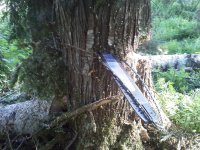Shanesaw80
Tree Assassin
- Local time
- 4:09 AM
- User ID
- 7075
- Joined
- Aug 18, 2018
- Messages
- 395
- Reaction score
- 2,403
- Location
- Alberta, Canada
Can i quote you twice ? This was a humboldt face followed by a regular back cut ,maybe 30% face cut ,left room for the wedges to go in all the way for lift ,it was a hill side so ground on other side of cut was about 8 feet down so cut it from the high side of the hill ,if i would have cut a deep face ,i would have ran out of room for pounding to get the tree to tip sideways on the hill ,this is where the wedges were when it went over ,i pounded it over with a 3 lb axe ,so there must be some math in there for lift vs speed vs something else ,or could just say the turtle was faster than the hare this time .so cut ,wedge ,cut some more pound some more ,keep cutting ,pound some more ,till it makes noise then step away and pull the saw out of the tree .View attachment 179125
Once you get your wedges set good you could always just finish your backcut and then pound your wedges to get the tree over. It’s fine to do it like you said, cut-wedge-cut-wedge-etc.... It just takes a whole lot more effort to pound those wedges in with an excessive amount of hinge still left. Once I have my wedges secure I complete my backcut and then wedge it over. Much easier to move the tree when your backcut is completed. Just a thought....
Those wedges in the picture are in there deep. With thicker bark it’s nice to shave the bark off the back first so your wedging completely into solid wood. With 3 wedges it’s also easy to pull 2 out and stack them while the 3rd offset wedge is holding your tree up to get more lift, makes life a little easier at times.
Great job getting it done, just throwing some things out there that may make your life easier.







